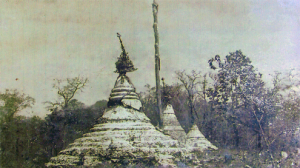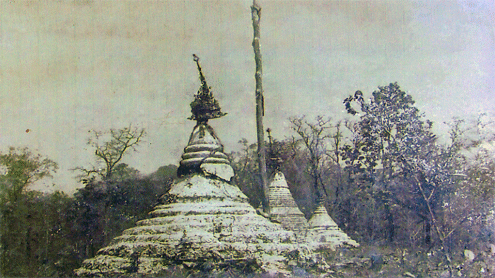
Akka : Three ancient pagodas rise up from now dry land which, only a few months ago, was submerged below river waters. Sangkhlaburi, along with other lakeside communities popular with tourists, have been experiencing dramatic decreases in its water levels.
Villagers have reported to IMNA that they do not remember ever being able to see the ancient Pagoda.
However due to low water level, researchers and tourists from all over Thailand have been coming to see the historical Pagoda. The amount of interest being generated for this site from researchers and tourists has been further raised due to the Government’s recent initiative to promote Thailand’s pagodas.
The Three Pagodas were made by Mon people over 400 years ago. Many Mon fled to Thailand during this time because the Mon Kingdom was defeated by the Burmese army in1594. The Three Pagodas mark what used to be the border with Burma.Once arriving in Thailand the Mon built several pagodas, such as this one, the pagoda was built as a tribute to peace and ending conflict.

Despite the pagoda’s historical significance, in 1984 the Thai Government completed the construction of a hydroelectric dam based in Thom Pha Phum to serve Kanchanaburi District. As a result the water flooded the old town of Songkhalaburi and the Three Pagodas.
The Dam, first named the Khao Laem Dam, and later renamed to Vajiralongkorn Dam, powers three 100MW hydroelectric turbines, powering Kanchanaburi province. Additionally, according to EGAT the dam controls seasonal flooding and provides irrigation water for farmers.
The reservoir is fed by three rivers, the Sangkhlaburi, BeKey and Landdi. While water levels typically drop during hot season, Thailand is suffering from a significant drought that has emptied the lake into area irrigation ditches. According to Thai news sources, twenty-seven of the dams in Thailand have experienced nearly fifty percent water evaporation.
However some area residents also suspect the unseasonably low water level is due to the formation of a crack near the Vajalonkorn dam in Tong Pa Pume after a minor earthquake in 2006. The dam, which is situated over a fault line, has been considered a high-risk area for earthquake damage, according to the Thai newspaper The Nation.
Residents in Tong Pa Pume have reported that the dam has been opening all three of its run off gates in the evenings, and traffic towards the dam face is restricted.
Despite the attraction of the previously submerged pagodas, residents have reported some negative impacts including the cleanliness of drinking water and more frequent disruption of electricity. For reservoir side villages, a continued drop in water levels could impact local economy including, tourism, trade, and fishing.
Nai Chit Nge, who has lived in a houseboat on reservoir for over twenty five years, reported to IMNA that “We have been lived here for a long time. The water was at 226 inches at this time last year, while it is at 108 inches now.”

